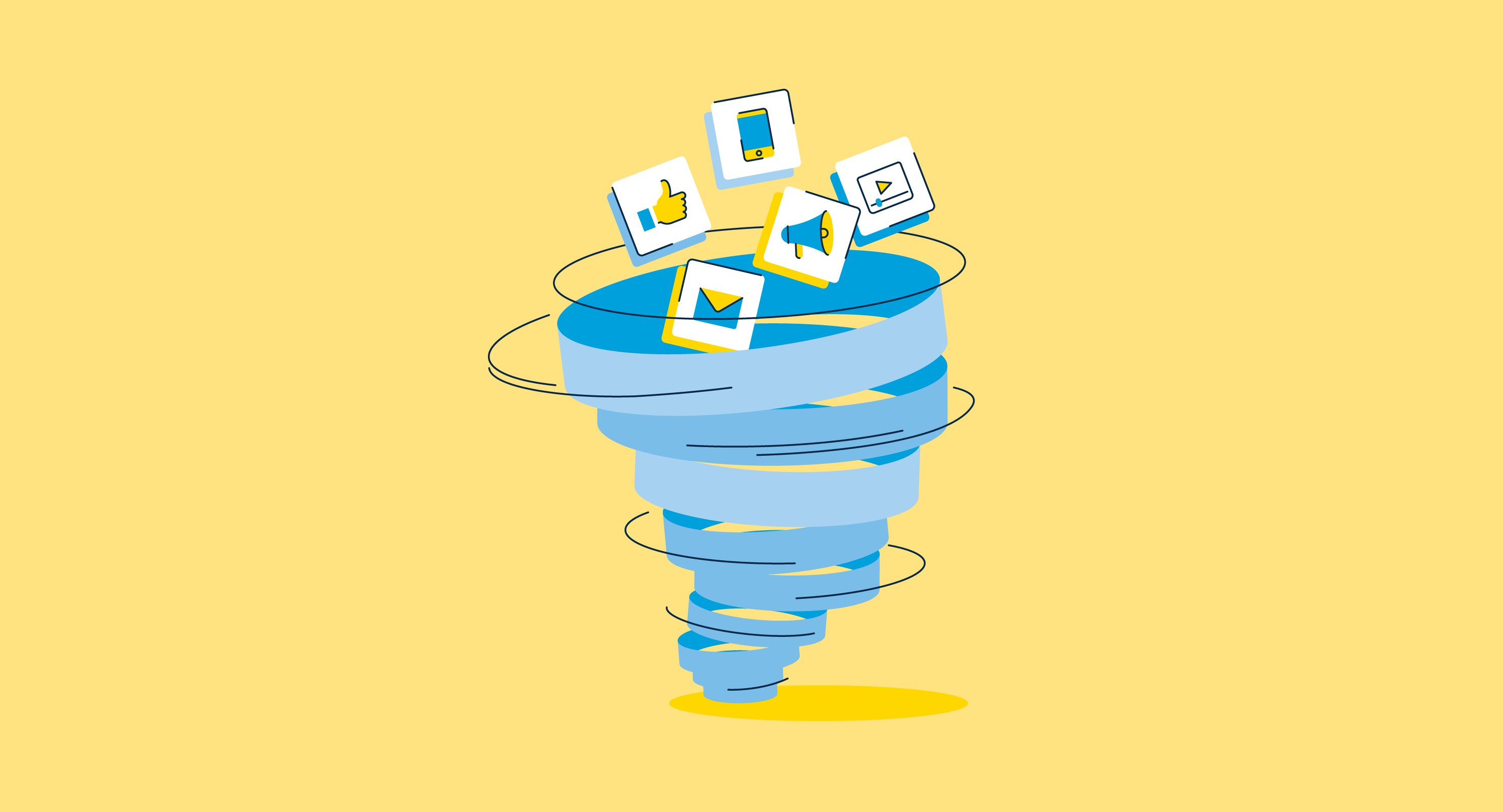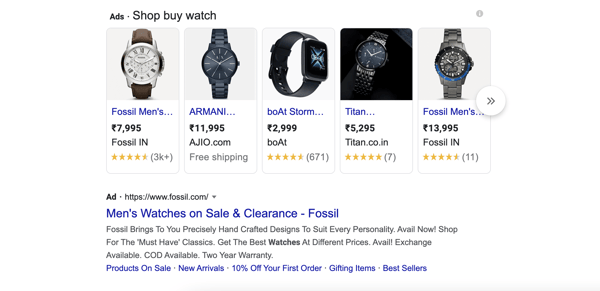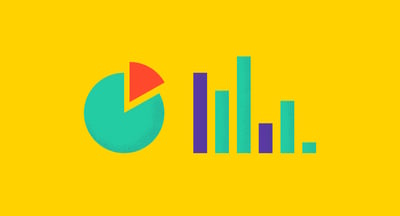July 8, 2021
 by Ninisha Pradhan / July 8, 2021
by Ninisha Pradhan / July 8, 2021

By the time you finish reading this, thousands of digital marketing campaigns will have been launched
The world is all digital, and we're just living in it. We went from newspaper advertisements and billboards to social media banners and online events. Considering that you'd be hard-pressed to find something that wasn't sold online, it was only a matter of time before marketing and advertising became digital as well.
Regardless of the industry they're in or what their role is, everyone's involved with or impacted by some form of digital marketing or digital marketing services at some point in their lives. If you have a website, social media channels, a blog, or send out emails, you've performed the act of digital marketing. People have become increasingly comfortable using the internet and all that it has to offer. So why not leverage that to strengthen your digital presence?
Let's dive into the world of digital marketing and everything you need to know to be a step ahead of the competition.
Digital marketing comprises marketing and advertising efforts that are created and distributed through digital channels such as social media, websites, email, search engines, mobile devices, or mobile apps. Digital marketing is a mix of paid efforts such as digital ads and social media campaigns, and organic efforts like videos and podcasts.
Any online marketing effort can fall under the umbrella of digital marketing. Despite being newer than other marketing efforts, digital marketing has become a large part of what drives marketing forward.
As the internet continues to evolve, digital marketing will continue to grow. In the 2000s, companies flirted with the idea of digital marketing. With social media hitting its stride in the 2010s, digital marketing became a more aspiring strategy to adopt. Today, everyone is doing it. It's no wonder that digital marketing is used interchangeably with the term internet marketing.
Today's marketing experts are expected to demonstrate some level of understanding of digital marketing. We've scratched the surface of digital marketing, but there's still so much to explore and learn.
To sell something, you need to know where the market is.
With most businesses acquiring their prospects online, it makes sense to focus marketing efforts online as well. However, digital marketing is more than just a method of marketing done online. It's a precise, data-driven form of marketing that any company should take seriously.
Here are a few reasons why digital marketing is essential for fulfilling modern business marketing requirements.
The digital world has no borders.
Customers across the globe will have similar problems or are looking for a solution. If your business can address these needs, it's an excellent market opportunity to engage with them.
With the help of digital marketing, companies can reach prospects from any part of the world and conduct business with them. It's an excellent way for businesses to become international without physically stepping foot on foreign soil. Today, internationalization, such as content internationalization, has become attainable for small businesses on Instagram that can ship retail goods to different countries that resonate with their products. Retail image recognition software is helping retailers showcase their products to the right
On the other hand, digital marketing also increases your reach within a specific geographical region. For example, a billboard or a flyer is visible within a two-mile radius, but a banner ad on Google can be seen by an entire city, state, or country.
Marketing can be expensive. Paid campaigns require a lot of planning since there's a limited budget allocated. This is where targeting becomes crucial for advertisers and marketers.
You could launch more broad-based campaigns with only a few demographic filters, but that doesn't mean you'll get more hits on the campaign. For instance, your business could be selling sugar-free vegan ice cream. You could set the campaign for adults in the age group of 18-60 who live in North America, but how many people in this demographic would buy your product?
Digital marketing allows marketing teams to target customers based on their interests, awareness level, and demographic details. These data points are obtained from users' internet searches, usage, and the information that they put out on social media. Marketers can craft a comprehensive buyer persona from these inputs and push campaigns seen by the right set of people. With this data, retargeting is also possible, allowing marketing professionals to reel lost leads back into the marketing cycle.
If we go back to the ice cream example, your buyer persona tells you that the ideal prospects are vegans in their 20s or early 30s, residing in metropolitan cities like Los Angeles. Focusing your campaign spend on this demographic gives you a better return-on-investment (ROI) on your campaign, and you get leads that exhibit a much higher chance at converting.
Being able to target the right set of people also means that there's audience data available at your fingertips. A rough idea of what the target audience wanted was sketched out in traditional marketing, and a standard marketing campaign would be distributed accordingly. With the advent of digital marketing, data for every individual is accounted for and can draw invaluable insights.
Take a ridesharing service like Uber. The problem statement is: providing transport on the go, at any time and any place.
While this rings true for anyone looking for a ride, people's motivations for using such a service can wildly differ. For example, maybe someone lived in a crowded city and never needed to learn how to drive or get a license. Another might be a senior citizen who can't see well but wants to make regular trips to see their grandchildren who live across the city.
Gathering customer data can help companies like Uber create different ad copy, campaigns, or tailored messaging that hits their intended audience with the right amount of positive impact. Of course, the amount of data collected can be immense, but luckily, customer data platforms can help marketing professionals assemble and segment information into curated personas.
The beauty of digital marketing is how unbiased it is toward any business. Your business could be a startup or a giant enterprise spread across different continents, but the rules would still be the same.
With traditional marketing, creativity and research go a long way. But the unspoken rule is that "the one with deeper pockets sees wider results". Billboards and TV ads are expensive. A smaller business can’t compete with a larger company simply because they can’t afford to.
This is where digital marketing evens the playing field.
Posting an ad online still costs money, but it costs peanuts compared to a nationwide television campaign. With online channels and digital platforms, a small business that started in a garage somewhere could rank better than a giant conglomerate, provided their digital marketing game is strong.
People have become proficient in creating social profiles and using hashtags, knowing the best times of the day to post, and speaking the language of their target audience. You don't need a lot of money to master these tactics; you just need to understand digital marketing well.
You have a billboard propped on a highway. How do you measure its effectiveness or its performance? You could argue that because it’s a busy thoroughfare, a lot of eyes are on your ad.
But your billboard isn't the only one out there, right? What are the chances that someone saw another billboard and not yours? A bigger question would be if someone did see your billboard, how many of them were compelled to buy your product or take any action? What were the results of the billboard?
With digital marketing, all these questions and more are answerable. Everything online is quantifiable. Every click, every comment, and every conversion is accounted for. Digital marketing channels track the engagement rates of every post or ad a business puts out. This is an excellent insight to know which digital marketing campaigns performed well and which ones failed to hit the mark.
It also sheds light on the source from where leads or new customers originate. By adding d Urchin Tracking Module (UTM) parameters that help track every conversion and its source better; whether from a landing page, social media post, referral, or search engine result, UTM parameters give better visibility to digital marketers about the performance of each online campaign. Knowing the source helps marketing teams hone in on which channels work the best for them and focus most of their efforts on those.
Beyond knowing which channels worked best for a particular campaign, tracking and monitoring a lead's movement before it culminates its journey as a customer is crucial for marketers. A typical battle that marketing teams endure is whether marketing or sales efforts convert a prospect. Digital marketing provides all the data needed to show how a lead was nurtured, for how long, and whether the closure could be attributed to marketing efforts entirely or partially.
Digital marketing encapsulates several individual divisions within marketing. A business may not have all the divisions associated with digital marketing, but that doesn't mean they aren't pursuing a digital marketing strategy. Typically, a combination of different types of digital marketing allows for optimal results.
Let's look at some types of digital marketing businesses use as a part of their marketing strategy.
From the plain, text-based pages of the late '90s to today's interactive pages that look more lifelike than ever, websites have come a long way.
A no-brainer, websites are the first step into the digital world for businesses. These are not to be confused with splash pages, an introductory screen that greets visitors before they land on the website's homepage. A website is where the target audience begins to interact with a company, indicating that there's some interest generated. If there were ever a place that businesses could put their all in, it would be the humble website.
Websites are busy workers and that's why it's essential to maintain high availability for them. It’s responsible for building brand awareness, generating interest, educating visitors, and converting prospects. It's important to note that each of these goals is large enough on its own and requires individual focus; a whole website has to carry all this load while looking appealing and interactive.
This is why designing and developing a solid website using content management plugins is vital for any business in the digital age. Good website design not only makes a great impression on internet users, but it should also be compelling enough for a visitor to linger and take action on the page.
Top 5 website builders:
*These are the five leading website builders from G2’s Summer 2021 Grid® Report.
While websites are more of a medium than a digital marketing process, they should still be considered essential digital marketing strategies. This holds true even today, with so many companies constantly reworking their websites.
Here are two things that companies get wrong when they conceptualize and design a website for their business:
A good website should exhibit ARE: Build Awareness, Resonate with the audience, and Educate visitors. Messaging ties all three elements together to create the maximum impact on an individual. However, if your business isn't clear about the messaging, how do you expect your prospects to understand its offerings?
For example, an amusement park is supposed to be a fun destination with cool rides. But if the flyers advertise a museum attraction instead of the rides, the intended audience (children between the ages of 6-14) will be confused and wouldn't want to go to such a place.
On the other hand, companies that keep trying to chase industry buzzwords will have websites that never see longevity. These are the kinds of organizations that have multiple website revamp projects within a year or two. This usually happens when stakeholders fail to agree on one core message and juggle too many things simultaneously.
Establishing the right message at the very beginning eliminates the need for any confusion, maintains consistency, and drives a better brand recall with the audience.
Can a dictionary substitute a book? Both have words and pages, so why not?
There's a reason why sales presentations cannot be substitutes for a website. One is supposed to push people to convert, while another is supposed to show what's available and what the business does.
A product or service is intended to solve a problem. Customers are smart enough to figure out what they need. So your website should say: "We understand that this is a problem you're facing, and here's what we have to combat it." This may seem similar to what a sales pitch would sound like, but there is a difference.
Any good sales deck is story-driven. A story is crafted around the prospect that the business is engaging. Comparison tables, charts, and statistics are all elements within a sales presentation.
That doesn't mean websites can't be story-driven. They can. The question is whose story are you going to tell? Internet users that visit a website come from different sources and backgrounds, and have varying needs and problems that have to be solved. Even if a business caters to multiple industries, several unique user profiles within each sector need to be accounted for. You can't mesh dozens of different buyer personas to fit into one standard website copy.
Keep the website relatable to a larger audience. Anything very specific can be covered in a sales deck when interacting with prospects or through content like whitepapers, case studies, videos, and eBooks.
If marketing were a human body, content would be the carbs powering the entire system.
Digital media has only grown more prominent over the years. With the internet becoming far more accessible than ever before, web users have found channels to create, post, and share their content. As a result, there’s so much information out there being produced and only continuing to grow every minute.
When people think about content marketing, blogging is the first thing that comes to mind. While blogs are content in their most traditional form, content marketing isn’t limited by this. Contrary to common belief, content marketing is more than just written content.
Instead, content marketing is a dynamic marketing function responsible for educating the audience, building awareness, generating leads, and increasing a company’s reach and brand recall. From the website copy to the case studies highlighting a product’s efficiency, content marketing forms the core of any marketing or advertising strategy.
Businesses need to figure out which content form is being consumed the most currently by their target audience. For example, do your prospects prefer reading or do they like video content instead?
Content forms also depend on which stage of the funnel a potential customer is currently in. For example, if a visitor has no prior knowledge of a business and is in the exploratory phase of their buying process, they’ll need top-of-the-funnel (TOFU) content. Examples of TOFU content include blogs, videos, social media posts, infographics, and images.
If the visitor is interested in knowing more about the company and is currently in the evaluation stage of the process, they require middle-of-the-funnel (MOFU) content. MOFU content is more technical than TOFU content, with assets like whitepapers, solution briefs, product modules, eBooks, buyer guides, and surveys being provided at this stage.
Finally, if a lead is in the process of being converted into a customer and is in the decision stage, they’ll need bottom-of-the-funnel (BOFU) content. BOFU content is extremely company-centric since this is the phase where prospects need to be sold on the organization's business offerings. BOFU content includes demos, case studies, on-demand webinars, speaker notes at an event, free trials or tutorials, and comparison charts.
.png?width=600&name=TOFU%20vs.%20MOFU%20vs.%20BOFU%20(2).png)
Here are five examples of content marketing being utilized in everyday business operations and their impact:
Whoever said that blogs were dead probably doesn’t believe in marketing as well.
Beyond being hubs of information, blogs or articles can also provide some of the best ranking opportunities on search engine results pages (SERPs). This is because the more content a business has, the better its visibility online.
That doesn’t mean pumping out loads of content without rhyme or reason will help. Content marketing isn’t that straightforward. There is a strategy involved that comes out from thorough research.
Companies looking at blogging need to keep these things in mind:
Blogs are primarily created to build awareness, making it a TOFU instrument. Companies can’t and shouldn’t expect blogs to generate leads and drive conversions. At this stage, a visitor is in its exploration stage. Blogs guide a user through discovering a product or service, understanding how such a product can solve their problem, and educating them on other aspects of the topic. Content scheduling systems are key to many company blog's.
Videos are the content form of the 21st century. Now that we can record videos using our phones and view them in real-time without needing chunky VCR tapes (remember those?), video content has become more widespread than ever.
Businesses that aren't producing videos for their content needs are seriously missing out. Here are a few statistics to note about video marketing:
Just like blogs, videos are also TOFU content used to increase awareness. The advantage of video content is that one can explain a lot more in a few frames in less time than you could in a few pages. In addition, they’re easy to consume, share, and repurpose as well. For example, soundbites or short video clips highlighting a critical point can be cut and reused as shareable content.
However, producing videos is a complex skill to master. Not only do you need to know how to use a camera and understand the proper lighting or shooting conditions, but you also need to be adept at editing as well. Videos are easy to record; high-quality videos aren't. The importance of a video editor only seems to grow over the years. Having a good video editor on hand can help a company create quality content that performs well.
Podcasts join the ranks of blogs and videos as TOFU content. They're incredible tools for not only building brand awareness but also for establishing thought leadership. Podcasts are also a great way to initiate influencer marketing by having industry experts or "influencers" participate in an episode. This builds the credibility of any company and can be used as a form of social proof.
Like videos, podcasts are sensory forms of content. However, while videos are auditory and visual, podcasts can stand alone with just an audio feed. That's not to say that podcasts can't be visual; many popular podcasts work in a video format.
The key to a successful podcast depends on several factors. Some of these are:
Whitepapers are text-heavy documents. But unlike a blog or an article, these are more technical and have a business-like tone. Since whitepapers are written for a more informed audience, these are perfect vessels for MOFU content. At this stage of the funnel, leads seek very particular answers about the product and its capabilities that a website or an article can’t cover.
Whitepapers are used to generate leads in the form of gated content. Interested prospects would download a whitepaper after giving out a few details on a lead generation form. Since people are willing to give their data in exchange for content, the whitepaper being offered must be worth their time.
Here are some things you should avoid when putting together a whitepaper:
Like whitepapers, case studies are MOFU content. Marketing teams can generate marketing qualified leads (MQLs) from individuals that provide their details on a form and download a case study.
Case studies are a prevalent form of obtaining leads. Prospective buyers want to know who’s used the product and how the product helped solve a problem. This is where businesses can highlight their product’s capabilities. Case studies can be text-based or in a video format. Video case studies would have the client speaking about the product favorably. Prospects trust video case studies more since the client's face and words are being displayed.
In affiliate marketing, digital creators partner with brands that align with the content they put out on their channels. These creators promote the brand they tie up with and earn income based on the number of people who purchase merchandise through their affiliate links.
Top 5 affiliate marketing software:
*These are the five leading affiliate marketing software from G2’s Summer 2021 Grid® Report.
Affiliate marketing is a win-win situation for both the affiliate marketer and the business they’re partnering with.
Affiliate marketers get a neat cut of every purchase done by a customer using the affiliate link or affiliate discount code. It’s a great side gig for influencers looking at making some extra cash through their content.
Brands or merchants that partner with affiliate marketers or use get to tap into a loyal audience base that fits their buyer persona to a T. Affiliates work hard to build a steady audience that actively consumes their content.
People trust these creators or influencers because they’re real people that aren’t actors paid to endorse a product on TV. If an affiliate is using or advocating a product, chances are they use this product and show their support for it. Affiliate marketers and influencer whitelisting amplify a brand’s voice amongst the right crowd and help build credibility around it.
These are the niches that drive the highest number of affiliate programs:
Email marketing provides the highest ROI than other marketing tactics. Yet, most people get it wrong.
Think back to the last time you received a promotional email. Was it something you clicked on? Or did it immediately get sent to spam?
The reason why people dislike getting promotional emails is that they’re blatantly promotional. “But an email campaign is supposed to be promotional, right?” It is, but there are better ways of going about it.
Email marketing requires a ton of groundwork. “Batch and blast” email strategies are ineffective and should be done away with. Instead, like every other digital marketing strategy, email marketing should be data-driven.
Did you know? Batch and blast email campaigns include sending one standard email to many email subscribers in an email list. It's also referred to as bulk emailing.
Email segmentation is a shining example of how email marketing strategies can incorporate data. It requires collecting different data types to create a rough idea of what the contact base looks like, the common characteristics shared by people within this list, and how best to group them.
As opposed to sending large batches of emails to every contact in a CRM, email segmentation helps businesses push relevant messaging to the right set of people.
Some of the benefits of email segmentation include:
In email personalization, marketers use the information they have on each individual and create customized email bodies that utilize information specific to one user. This could be in the form of names used in a subject line or addressing a person's designation and location within the email.
By combining segmentation, email personalization becomes much more manageable and highly effective. As a result, subscribers get emails relevant to them, and businesses get successful campaigns that don’t end up in the trash.
Top 5 email marketing software:
*These are the five leading email marketing software from G2’s Summer 2021 Grid® Report.
As the name suggests, SEO is the process of optimizing or improving a company’s page on the SERP. Search engines display various links to pages and websites in a particular order that changes from time to time. The position of each page is called its rank. Ranks determine how visible a particular webpage is online to the average internet user.
SEO is often confused with search engine marketing (SEM). The two can be distinguished by one factor: SEO utilizes organic strategies to rank better on SERP, while SEM uses paid methods to appear on SERP.
SEO can be segregated into a few key types:
Top 5 SEO software:
*These are the five leading SEO software from G2’s Summer 2021 Grid® Report.
Social media promotion has effectively changed the way the internet looks, feels, and sounds today. What was once the watering hole for college students or high school kids has now become a place for all ages and backgrounds across the globe. While organic social media posts don’t generate leads or conversions, it’s vital for building awareness and growing a company’s presence. The future is social, after all.
Since most people spend a considerable chunk of their time on social media, it’s only natural that businesses began to shift their focus on digital platforms. Several social media and email marketing software tools are available in the market for specific goals to optimize marketing efforts across these platforms.
Top 5 social media management software:
*These are the five leading social media management software from G2’s Summer 2021 Grid® Report.
While most online platforms make up the spectrum of social media, each forum differs widely from one another. Let’s look at five of the biggest social media platforms and how each business can leverage its full potential.
LinkedIn is a professional networking platform where companies can recruit candidates, post updates about the business, and run digital campaigns for building awareness or generating leads. It's like Facebook for companies. While anyone can create a profile on the platform, LinkedIn predominantly comprises Baby Boomers, Gen X, and older Millennials. It's geared toward a more mature audience.
Because LinkedIn targets a specific demographic and is more for businesses than friends and family, the marketing tactic will change. Here are some elements that digital marketing professionals use on LinkedIn:
LinkedIn at a glance:
*Figures obtained from LinkedIn, LinkedIn Business, Webfx, The B2BHouse, and HubSpot
Instagram is dominated by the youth, specifically Millennials and Gen Z users. It's one of the youngest platforms to come out and has since snowballed into a worldwide phenomenon.
Starting as a digital photo album where users could post pictures of their day-to-day lives and get likes or "hearts" under each post, Instagram's become a zeitgeist of cultural change. Users today can share videos, have live streams, create Reels or 15-second video and audio clips, set up stores for e-commerce, and now even create and publish blogs or articles in a recent update.
While influencer marketing isn't a new thing, Instagram has managed to become a breeding ground for influencers, paving the way for young "Insta-stars" that partner with brands ranging from apparel and skincare to home decor and restaurants.
Instagram is B2C-focused, not having a sizable B2B audience established as of now. But the platform is known for regular updates and introducing new features that increase the longevity of the social media channel.
With its large user base, Instagram is an ideal platform for advertising. Back in the late 2010s, advertising on Instagram was inexpensive. However, with the platform becoming more crowded and more users utilizing Instagram ads to reach new audiences, ad costs have steadily increased over the years.
Instagram at a glance:
*Figures obtained from Instagram, Wordstream, Falcon.io, and Lyfe Marketing
Facebook is one of the largest social media platforms with a whopping 2.85 billion users. Back in the late 2000s, Facebook was extremely popular amongst the younger crowd. Today, most active users on Facebook are Gen X, Gen Y or Millennials, and a few Baby Boomers who are comfortable using digital technology.
Because of the sheer volume of active users on Facebook spread worldwide, marketers and advertisers include Facebook as a focal point for their digital campaign efforts. Today Facebook marketing has become a subset of its own within social media marketing. Like Instagram, Facebook is also B2C-focused rather than B2B. But there are some instances of B2B marketing occurring on the platform with businesses eyeing Facebook's user pool for brand awareness and event announcements.
Facebook at a glance:
*Figures obtained from Facebook, Wordstream, RevealBot, and Facebook Business
Twitter is a microblogging and social networking service where posts and messages are called ‘tweets’. Unlike other social media platforms, Twitter imposes a strict character limit on each tweet. Each tweet couldn’t exceed 144 characters until 2017 when the character limit increased to 280.
Twitter embraced hashtags to group relevant content within the platform after users complained about seeing unorganized and irrelevant content on their feed. Today, the concept of hashtags is prevalent across all social media platforms, with Instagram incorporating them within their DNA from the first day that the platform launched back in 2010.
Twitter has become synonymous with celebrities and famous personalities within an industry sharing their views succinctly in tweets and images. This is due to the platform’s capacity to get topics ‘trending’ and gain worldwide attention and engagement. While most social media platforms are capable of going viral, Twitter has seen several instances of virality within the channel.
Twitter at a glance:
*Figures obtained from Twitter, Statista, Twitter Business, and Webfx
YouTube is the most popular video-sharing platform in the world. YouTube has videos on every subject matter imaginable, from educational content to entertainment. Many entertainers made their start from YouTube and have catapulted into stardom. Taking inspiration from TV channels and incorporating it within the platform, users with a YouTube account also have channels to produce and post content on.
It's helped popularize trends, making content or people go viral, with videos that earn millions of views every minute. Since being acquired by Google in 2006, YouTube has managed to be the premier video platform for all demographics.
Running ads on YouTube can be done by creating a Google Ads account and setting up a campaign. Since it's a video-sharing platform, naturally, most of the ads are in a video format. However, there are banner ads that redirect visitors to another website or a video once clicked.
YouTube at a glance:
*Figures obtained from Google, Influencer Marketing Hub, Wordstream, and RevealBot
Marketing automation isn't directly associated with content creation, promotion, and advertising like the other types of marketing we've covered so far, but it's also considered to be another type of digital marketing. With so many channels and platforms available online, it becomes hard to monitor and publish digital tasks simultaneously. Marketing automation tools can streamline all these tasks to save time and provide an omnichannel experience for both marketers and customers.
Marketing automation tools essentially automate digital marketing processes. From posting on social media to sending out an email campaign, most manual tasks that are time-sensitive can be created beforehand and published at a scheduled date and time, depending on the requirements.
Top 5 marketing automation software:
*These are the five leading marketing automation software from G2’s Summer 2021 Grid® Report.
So far, we've covered various types of digital marketing. Social media is only one facet but is still one of the most prominent aspects of digital marketing. With all of these social media platforms, advertising plays a huge role. Campaigns and ads are a no-brainer considering that social media provides a large pool of people whose interests, online activity, and other profile data are all available to digital marketers. Running campaigns targeted at a specific persona or audience segment improves their performance and shows favorable results.
The question is: how do you measure the performance of a digital marketing campaign?
One of the most significant advantages of digital marketing or digital advertising is that they're data-driven. There isn't any ambiguity in launching ads and knowing where most of the ad spend has gone. Naturally, there are metrics used to measure the effectiveness of any digital marketing campaign.
Here are some of the most important metrics used to evaluate the performance of a digital ad:
CTR is a common term used in other forms of digital marketing but has a strong association with social media campaigns. In simple terms, it measures the total interaction users have with a campaign they see. The interaction here is in the form of clicks.
Click-Through Rate (CTR) = (Number of clicks ÷ Number of impressions) x 100
CPM is the cost of an ad campaign for every 1000 impressions. This metric is used for broader campaigns that target a large number of people at a time. In general, CPM costs are lower than other campaign methods. Once the platform distributing the ads approves the campaign, the digital ad posts only get charged for every impression created. Here, "impression" isn't singular but is instead in the thousands.
This metric is helpful for campaigns where the main goal is building awareness. A campaign that has more specific targets ideally shouldn't be using CPM.
Cost Per Impression (CPM) = (Cost to an Advertiser) ÷ (1000 impressions)
PPC refers to the method of paying for the ad that users click. It's a term used within online advertising platforms such as Google and Facebook. Whether you're running paid search ads, product listing ads (PLA), or social media campaigns, if you have a fixed budget, understanding the average PPC it costs for your business's industry is an excellent place to start.
PPC advertising works on the principle of auctions. Suppose you've set up campaigns on social media or used Google AdWords (Google's pay-per-click advertising platform). In that case, you'd know that any campaign is set up by fixing the audience, campaign objectives, ad format, and finally, the budget. When setting the budget for the campaign, usually, a maximum amount needs to be established. There's a bid placed on the targeted keywords.
The effectiveness of a Pay per Click (PPC) ad can be deduced from profit per impression or profit per click.
In comparison, CPC refers to the cost of every click of an advertisement or campaign within the platform itself.
PPC ads are what a business would run online, irrespective of the platform or channel. CPC is the cost of a PPC ad within a specific channel. CPC is a tangible, absolute value since the cost of every click is transparent. PPC isn’t as straightforward since it requires assessing the performance of a campaign across several parameters like clicks, impressions, profit, or loss generated.
Cost Per Click (CPC) = Cost to and Advertiser ÷ Number of clicks
Lifetime value refers to the value of revenue generated from an individual over the customer life cycle. The lifetime value of a customer should always be greater than the cost of acquiring one. If the acquisition cost is much higher than the value obtained from a customer, it’s a futile exercise, and such an individual shouldn’t be chased beyond a certain point.
A good rule of thumb is: Cost per Click ÷ Conversion Rate < Lifetime Value
Here are some more formulas used to calculate the performance of any digital campaign:
Digital marketing and inbound marketing are often used interchangeably.
.png?width=600&name=Digital%20marketing%20vs.%20inbound%20marketing%20(2).png) Digital marketing is a set of tasks or actions using tools or activities on a digital medium to achieve short-term goals. Digital marketing is excellent at building awareness, increasing visibility, and growing traffic.
Digital marketing is a set of tasks or actions using tools or activities on a digital medium to achieve short-term goals. Digital marketing is excellent at building awareness, increasing visibility, and growing traffic.
Inbound marketing utilizes digital marketing tactics on a long-term basis, keeping a defined marketing strategy in mind. Typically inbound marketing is instrumental in acquiring qualified leads and converting them into customers. Inbound marketing isn’t possible without digital marketing, so both of them go hand in hand.
The main difference between B2B and B2C digital marketing lies in the intent of the buyer.
B2B businesses sell products or services that usually require a more considerable commitment in the form of time, money, or both. B2B products are often subscription-based, requiring customers to be nurtured over a period of time.
B2C businesses sell a commodity that’s usually a one-time purchase. The sales cycle is quick, and the journey from awareness to the checkout stage is far shorter than in a B2B process.
Digital marketing for a B2B company shifts in tone, messaging, the platforms that should be focused on, and the content produced. A social media platform like Instagram isn’t ideal for a B2B organization to advertise on, whereas it’s perfect for a B2C company.
Similarly, the type of emails and the frequency at which email campaigns are sent to a contact list differs from a B2B and a B2C company. In both cases, sending too many emails isn’t a pleasant experience for subscribers, but B2C companies can get away with sending more email updates than their B2B counterparts. Unconventional subject lines, GIFs, and images are comfortable in a B2C email campaign but not so much in a B2B campaign.
|
B2B digital marketing |
B2C digital marketing |
|
The tone of content and messaging is more professional. |
The style of content and messaging is more casual. |
|
LinkedIn, Twitter, and Facebook are the preferred platforms. |
Instagram, YouTube, and Twitter are the preferred platforms. |
|
Email campaigns are informative, crisp, and sporadic in nature. |
Email campaigns are informal, exciting, and more frequent in nature. |
|
Digital campaign expenditure is usually high. |
Digital campaign expenditure is usually low. |
|
Content formats like whitepapers, case studies, and infographics are more prevalent. |
Content formats like pictures, blogs, and 15 or 30-second videos are more prevalent. |
Most marketers today are digital marketers. The term digital marketer is too broad to describe what an individual does. Any marketer whose work involves interacting with the online world is considered to be a digital marketer. Let’s look at a few types of digital marketers and what they do.
Digital marketing should be a strategy in every organization. How each organization adopts digital marketing depends on factors like company size, market recognition, the industry they function in, and the budget they have at their disposal. While digital marketing is universal, its implementation and execution aren't uniform from organization to organization.
Here are a few ways companies at any level can adopt digital marketing.
Startups face two problems from the get-go: budget and recognition. What startups need is a digital marketing strategy that builds awareness around the brand and is also cost-effective and budget-friendly.
It’s important to remember that while there are cost-friendly and organic digital marketing strategies, they still cost money. Assuming that organic means free is a cardinal sin in the marketing world.
At a startup level, getting the word out is pivotal for gaining recognition, acquiring customers, and seeing growth. Keeping the campaign goals as awareness helps companies stay focused and maximize results as opposed to having multiple goals and spreading themselves thin.
Here are a few things startups should consider when designing their digital marketing strategy.
At this level, companies have a bit more room to play around with. Budgets are considerably better than what startups can afford to spend, and businesses steadily built up a presence over the years. At this stage, scale or growth are the main goals.
Emerging businesses would keep lead generation as the campaign objective. They can achieve this by focusing on a few paid strategies while simultaneously utilizing organic tactics. There’s no escaping paid campaigns. While organic methods do show results, they’re more of a long-term game. Content and pages can’t rank in a few days. It takes weeks, sometimes months, to rank high on SERP. Midsize organizations need to see results faster before the competition captures the market share.
Businesses at this level should consider the following when designing their digital marketing strategy.

These are two different formats of SEM. At the very top, you see images of different watches, their prices, and their ratings. These are called product listing ads (PLAs). PLAs take up valuable real estate (the very top of a results page) and quickly list key details that a customer would be interested in. Furthermore, these ads are ideal for companies targeting individuals that have high intent to buy. Notice how the keyword “buy” in the search engine resulted in such a PLA. Other keywords like deal or discount also prop up similar results.
The second link is an ad as well, but this time there aren’t any images, no details about the pricing, and no ratings. It simply reads “Men’s Watches on Sale & Clearance - Fossil,” followed by a short description and jump links to pages within the website that potential customers interested in buying something would visit. These are called text-based ads, and they also appear on the top of the results page.
Organizations at this level should ideally adopt all the strategies we’ve covered so far. Companies at this stage have a comfortable budget to work with and have a team of marketing experts overseeing different aspects. Campaigns will only continue to grow in frequency, size, and quality.
While most aspects of digital marketing are taken care of, businesses at this stage should look at ways to connect with their customers and audience at a more personal level. Customers are automatically distrustful of large corporations since everything at the end of the day is business. As companies grow bigger, they begin to lose that human touch. Focusing on activities that provide value to the end-user is a great way to re-establish that connection with the audience.
Let’s look at a few things that established companies can consider when designing their digital marketing strategy.
There are many reasons why a company of any size should adopt digital marketing strategies for its business. It's data-driven which makes it precise, quantifiable, and justifiable. But the biggest reason why an organization should look into digital marketing is its innate ability to provide personalization. It's marketing that speaks to the audience, not at the audience. Digital marketing isn’t some new-fangled way of doing marketing. Only the medium has changed; the principles remain the same. At its core, marketing should resonate with the audience and empower them with enough information to complete a conversion.
Whether a business is large with a budget to play with, or small that needs to be frugal with its marketing spend, there's a digital marketing strategy out there for everyone. Look at what your company's immediate requirements are and hammer out the details of the business goals. Identifying which digital marketing strategy you need at every stage of the funnel is half the battle. Digital marketing has leveled the playing field for businesses of all sizes. Anyone can win the digital game as long as they have their strategies in place.
Learn how you can achieve conversion rate optimization through your digital marketing efforts in this guide.
Ninisha is a former Content Marketing Specialist at G2. She graduated from R.V College of Engineering, Bangalore, and holds a Bachelor's degree in Engineering. Before G2, Ninisha worked at a FinTech company as an Associate Marketing Manager, where she led Content and Social Media Marketing, and Analyst Relations. When she's not reading up on Marketing, she's busy creating music, videos, and a bunch of sweet treats.
For some people, marketing is just a word. For others, it is an aspiration to beat all the...
 by Daniella Alscher
by Daniella Alscher
Digital marketing is a vast field, and it continues to grow.
 by Rahul Varshneya
by Rahul Varshneya
In a world where new businesses are popping up every day, brand visibility is everything.
 by Lauren Pope
by Lauren Pope
For some people, marketing is just a word. For others, it is an aspiration to beat all the...
 by Daniella Alscher
by Daniella Alscher
Digital marketing is a vast field, and it continues to grow.
 by Rahul Varshneya
by Rahul Varshneya


